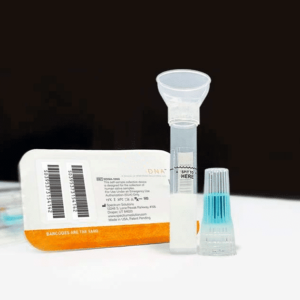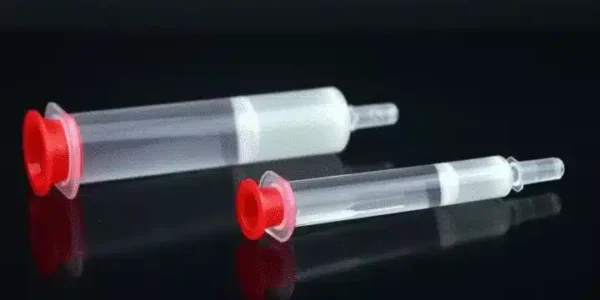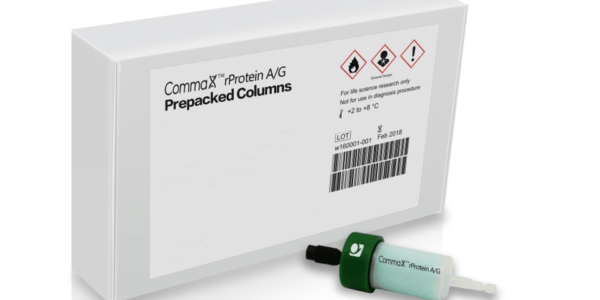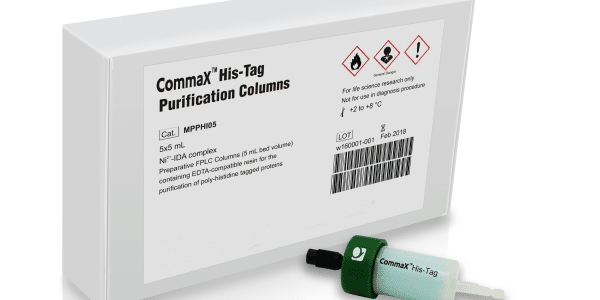Desalting Gravity Flow Columns
INTENDED USE
CommaX TM G-25 desalting gravity flow columns can be operated by gravity flow. They offer higher purification performance if operated by positive pressure via peristaltic pumps or syringes.
FEATURES
- Puncturable upper caps confer easy, tight connection with peristaltic pumps and syringes.
- Ease of use, no need for dedicated purification systems
SKU:
DG25003 / DG25012
Categories: Protein Desalting Columns, Protein Purification
Description
ORDER INFORMATION
| Cat. # | Description | Qty. |
|---|---|---|
| DG25003 | CommaX TM G-25 Desalting Columns, 0.8 mL/3 mL | 50/Box |
| DG25012 | CommaX TM G-25 Desalting Columns, 4 mL/12 mL | 20/Box |
DESALTING COLUMNS FOR SMALL MOLECULE REMOVAL
G-25 Desalting columns use the principle of size exclusion chromatography, also called gel filtration chromatography. In addition to desalting, the other main use for size exclusion chromatography is size fractionation.
The matrix beads in a size exclusion column contain pores. If a molecule or compound can enter the pores, it will move through the column by a longer path than any molecule or complex that is too large to enter the pores. Molecules that do not enter the pores will move through the column with the mobile phase, whereas molecules that can enter pores will be retarded and elute after these larger molecules. The size exclusion limit is the upper range of molecular size that can enter the pores.
In desalting, there is a large size difference between the target molecules in the sample and unwanted salt or small molecules. A size exclusion limit is chosen that is lower than the size of the target molecules (that is, target molecules are too big to enter the pores of the beads). Therefore, they are excluded from the pores, remain in the mobile phase, and are eluted after the void volume. Salts and other small molecules are retarded by the desalting column and are thereby separated from the target molecules. Desalting is sometimes called group separation mode.
In fractionation by size, all the molecules to be separated are below the size exclusion limit of the column and are retained by the column. The amount of retardation of each molecule is related to its size (and shape). This results in sequential elution of the molecules by size.
The two types of size exclusion chromatography require different columns. G-25 Desalting columns have packing and dimensions that allow for elution of the excluded molecules just before one column volume of mobile phase has passed through the column. Therefore, a desalting column is usually short and broad, whereas for size fractionation, the longer the column, the higher the resolution.
BeingBio has an extensive range of both fractionating and desalting columns. The next sections describe the uses and selection of desalting columns.
DESALTING COLUMN USES
G-25 Desalting columns are used with both proteins and nucleic acids. They provide a fast, simple way to purify these biomolecules away from salts and small molecules. Common uses of desalting columns include:
- Removal of salts
- Removal of low molecular weight molecules, for example, cofactors, inhibitors, and contaminants
- Buffer exchange
- Stopping reactions between macromolecules and low molecular weight reactants
- Removal of unreacted radioisotope from a sample
- Removal of primers and primer-dimers from PCR reactions
- Removal of dNTPs and other nucleotides
- Removal of dye terminator from sequencing reactions
Additional information
| Product No |
DG25003 ,DG25012 |
|---|---|
| Packing Size |
20 pcs/pack ,50 pcs/pack |
Shipping & Delivery
Related products
Desalting Prepacked Columns
$75.99 – $339.99
Select options
This product has multiple variants. The options may be chosen on the product page
His Gravity Flow Columns
$199.00 – $299.00
Select options
This product has multiple variants. The options may be chosen on the product page
His-Tag Purification Prepacked Columns
$249.99 – $999.99
Select options
This product has multiple variants. The options may be chosen on the product page
rProtein A, G, A/G Prepacked Columns
$249.00 – $299.00
Select options
This product has multiple variants. The options may be chosen on the product page








